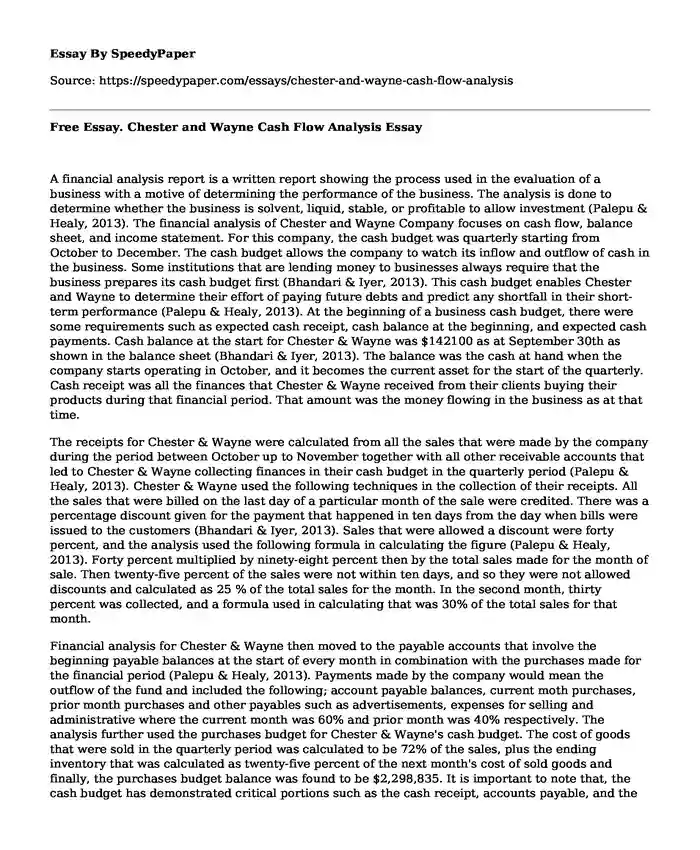
| Type of paper: | Essay |
| Categories: | Budgeting Money Financial analysis |
| Pages: | 3 |
| Wordcount: | 687 words |
A financial analysis report is a written report showing the process used in the evaluation of a business with a motive of determining the performance of the business. The analysis is done to determine whether the business is solvent, liquid, stable, or profitable to allow investment (Palepu & Healy, 2013). The financial analysis of Chester and Wayne Company focuses on cash flow, balance sheet, and income statement. For this company, the cash budget was quarterly starting from October to December. The cash budget allows the company to watch its inflow and outflow of cash in the business. Some institutions that are lending money to businesses always require that the business prepares its cash budget first (Bhandari & Iyer, 2013). This cash budget enables Chester and Wayne to determine their effort of paying future debts and predict any shortfall in their short-term performance (Palepu & Healy, 2013). At the beginning of a business cash budget, there were some requirements such as expected cash receipt, cash balance at the beginning, and expected cash payments. Cash balance at the start for Chester & Wayne was $142100 as at September 30th as shown in the balance sheet (Bhandari & Iyer, 2013). The balance was the cash at hand when the company starts operating in October, and it becomes the current asset for the start of the quarterly. Cash receipt was all the finances that Chester & Wayne received from their clients buying their products during that financial period. That amount was the money flowing in the business as at that time.
The receipts for Chester & Wayne were calculated from all the sales that were made by the company during the period between October up to November together with all other receivable accounts that led to Chester & Wayne collecting finances in their cash budget in the quarterly period (Palepu & Healy, 2013). Chester & Wayne used the following techniques in the collection of their receipts. All the sales that were billed on the last day of a particular month of the sale were credited. There was a percentage discount given for the payment that happened in ten days from the day when bills were issued to the customers (Bhandari & Iyer, 2013). Sales that were allowed a discount were forty percent, and the analysis used the following formula in calculating the figure (Palepu & Healy, 2013). Forty percent multiplied by ninety-eight percent then by the total sales made for the month of sale. Then twenty-five percent of the sales were not within ten days, and so they were not allowed discounts and calculated as 25 % of the total sales for the month. In the second month, thirty percent was collected, and a formula used in calculating that was 30% of the total sales for that month.
Financial analysis for Chester & Wayne then moved to the payable accounts that involve the beginning payable balances at the start of every month in combination with the purchases made for the financial period (Palepu & Healy, 2013). Payments made by the company would mean the outflow of the fund and included the following; account payable balances, current moth purchases, prior month purchases and other payables such as advertisements, expenses for selling and administrative where the current month was 60% and prior month was 40% respectively. The analysis further used the purchases budget for Chester & Wayne's cash budget. The cost of goods that were sold in the quarterly period was calculated to be 72% of the sales, plus the ending inventory that was calculated as twenty-five percent of the next month's cost of sold goods and finally, the purchases budget balance was found to be $2,298,835. It is important to note that, the cash budget has demonstrated critical portions such as the cash receipt, accounts payable, and the purchases budget (Bhandari & Iyer, 2013). This analysis enables the Chief Executive Officer and other decision-makers for Chester & Wayne Company to evaluate the performance of the company and to determine the potential of the business.
References
Bhandari, S. B., & Iyer, R. (2013). Predicting business failure using cash flow statement-based measures. Managerial Finance, 39(7), 667-676.
Palepu, K. G., & Healy, P. M. (2013). Business analysis and valuation: Using financial statements, text and cases.
Cite this page
Free Essay. Chester and Wayne Cash Flow Analysis. (2023, Jan 23). Retrieved from https://speedypaper.net/essays/chester-and-wayne-cash-flow-analysis
Request Removal
If you are the original author of this essay and no longer wish to have it published on the SpeedyPaper website, please click below to request its removal:
- Essay Sample about Locus of Control as a Factor to Academic Failure
- Free Essay on How to Compose Music
- Literary Essay Sample: The Use of Setting and Atmosphere in Dracula by B. Stoker
- Free Essay on the Factors Influencing Career Counseling
- Steps Towards Tennessee Secession, Free Essay in American History
- Essay Sample Answering on Why Are the US Citizens Rapidly Becoming More Obese
- Free Paper with Essays Analysis
Popular categories




